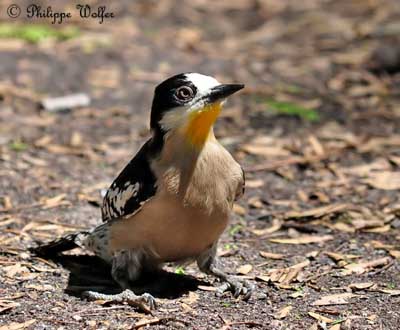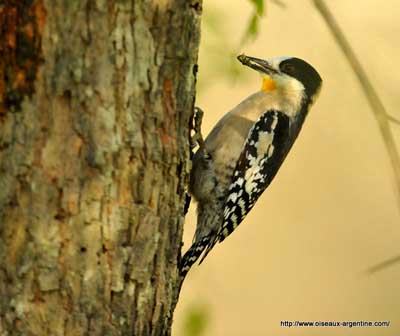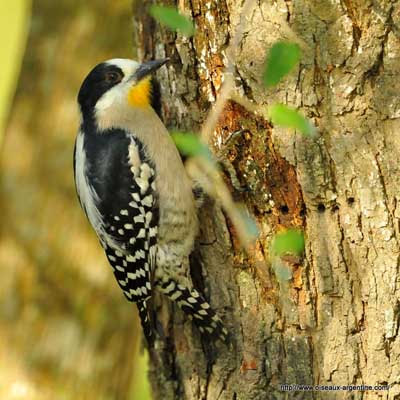
Fr: Pic des cactus
All : Kaktusspecht
Esp: Carpintero de los Cardones
Ital: Picchio dei cactus
Nd: Cactusspecht
Port: Pica-pau-de-testa-branca
Photographs by Philippe and Aline Wolfer
OISEAUX D’ARGENTINE
Text by Nicole Bouglouan
Sources :
HANDBOOK OF THE BIRDS OF THE WORLD Vol. 7 by Josep del Hoyo-Andrew Elliott-Jordi Sargatal – Lynx Edicions – ISBN: 8487334377
El Zoológico Electrónico (Damisela)
Internet FAQ Archives – Online Education
White-fronted Woodpecker
Melanerpes cactorum
Piciforme Order – Picidae Family
BIOMETRICS:
L : 16-18cm
Poids : 29-53 gr
DESCRIPTION:
This small woodpecker is found in South America. We can find some variations in throat colours, but all the birds belong to the same race. Usually, this woodpecker perches on large Cacti, giving the bird its name in several languages.
The White-fronted Woodpecker male adult has blue-black mantle and scapulars, with broad creamy-white vertical band in the middle of the mantle. The area from back to uppertail coverts is white barred or spotted black.
Upperwing coverts are black with blue gloss. The greater coverts are spotted and tipped white, medians are black spotted white. The flight feathers are blackish. Primaries are browner with white bars on bases. Secondaries and tertials show white bars on both webs.
The uppertail is black tipped white, and all the rectrices are barred white.
Underparts are buff with paler and greyer belly, and barred lower flanks and undertail coverts.
Underwing is brown barred white, except the whiter unbarred coverts.
Undertail is brownish-black and barred white.

On the head, male has white forehead and forecrown, lores, malar area and lower part of ear-coverts. A small red patch often partially concealed, occurs on central crown, between the white and black areas.
Rest of the head is blue-black, continuing down neck side and mantle.
Nape is whitish, washed buff or yellow, whereas the hindneck is pure white.
Chin and throat are white in southern birds, to partly or entirely yellow or golden in the birds of Bolivia and W Argentina.
The short black or grey-black bill is straight and chisel-tipped. Eyes are brown to red-brown. Legs and feet are grey.
Female is smaller and has shorter bill than male. She lacks the red patch on head.
Juvenile is browner with less glossy upperparts and more bars below. Both juveniles, male and female, show orange-red tinge on crown.
VOICE: SOUNDS BY XENO-CANTO
The White-fronted Woodpecker utters loud calls “weep-weep” faster during the displays. In the early breeding season, it performs short, weak drums at nest-site.
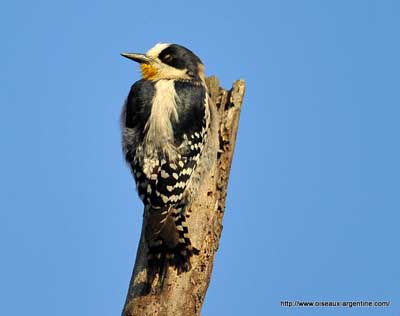
HABITAT:
The White-fronted Woodpecker frequents dry forest and edges, gallery forest, savannahs and bush country, and montane scrub with cacti of genus Cereus. It also can be seen in palm groves with trees.
This species occurs from lowlands to 1700 metres of elevation, and up to 2500 metres in Bolivia.
RANGE:
The White-fronted Woodpecker is found in C South America, in Argentina, Bolivia, Brazil, Paraguay, Peru (rare) and Uruguay.
BEHAVIOUR:
The White-fronted Woodpecker feeds on insects and fruits, and sometimes stores the food. But this bird also feeds on sap, and between June and September (cold season), it often drills holes in mesquite (Prosopis) to get the sap.
This feeding behaviour involves competition at these food sources.
The White-fronted Woodpecker seems to be very active at these resources and the smaller bird species cannot feed on sap sufficiently, due to aggression by this woodpecker.
However, the works of the White-fronted Woodpecker make this food available for other species.
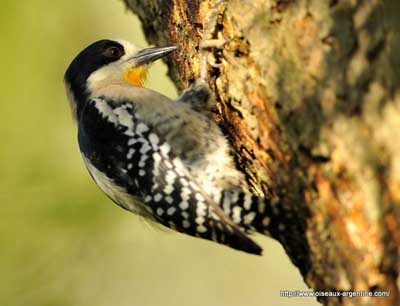
This woodpecker forages in palms, trunk and branches, gleaning and probing. It is usually seen in small groups of 3-5 birds.
During the breeding season, the White-fronted Woodpecker performs bowing displays, accompanied by calling, a fast “weep-weep”.
This woodpecker is probably resident in its range, only performing some seasonal movements.
FLIGHT:
The White-fronted Woodpecker has undulating flight as all the woodpeckers.
REPRODUCTION:
Breeding season occurs between September and December.
The White-fronted Woodpecker is co-operative breeder, with groups of several birds, up to 5 or more.
The nest is a hole excavated in dead tree, palm or cacti, with a preference for large cacti which are a perfect tree substitute for the small species.
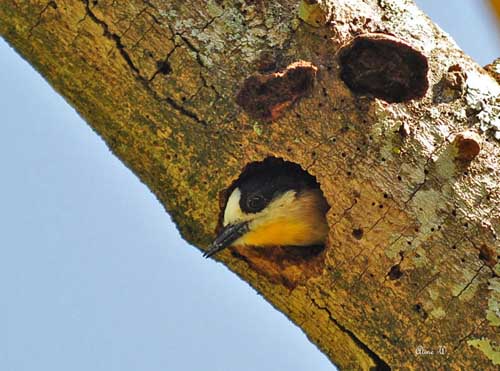
PROTECTION / THREATS / STATUS:
The White-fronted Woodpecker is relatively common in most part of the range, even locally very common in Argentina.
Populations seem to be secure for the moment.
